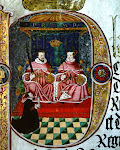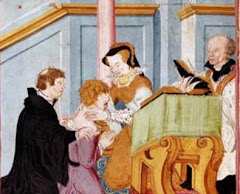The ballad was designed to be sung and thus broadcasted to many. Such a way of spreading news was necessary in an age where most could not read. The ballad allowed for some individuals who were gifted in reading to memorise it, sing to others and they too could learn the lyrics and communicate it to others. The ballad was printed in London and perhaps the ballad was confined to this area, although the Council at this time was making sure that reports of the pregnancy were sent to bishops across the realm so they could tell the populace. Perhaps part of their campaign involved spreading literature like this across the country?

The Ballad of Joy,
upon the publication of
Q. Mary, wife of King Philip,
her being with Child,
Anno Dom(ni) .15- . [1]
Now singe, now springe, our care is exiled.
Our vertuous Quene is quickned with child.
Nowe englande is happie, and happie in dede,
That god of his goodness, dothe prospir here seede:
Therefore let us praie, it was never more nede,
God prosper her highnes, god send her good sped.[2]
How manie good people, were longe in dispaire,
That this letel (little) englane, shold lacke a right heire:
But nowe the swet marigold, springeth to fayre,
That England triumpheth, without anie care.
How manie greate thraldoms, in englande were seene,
Before that her highness, was pwblyshed (published) as quene:
The bewtye (beauty) of England, was banished clene,
With wringing, and wrongynge, & sorrowes betwen.
And yet synce her highness was planted in peace,
Her subjects wer doubtful of her highness increase
But nowe the recofort, their murmour doth cease,
They have their owne wyshynge (wishing) their woes do release.
And suche as envied, the matche and the make
And in their proceedings, stoode styffe as a stake:
Are now reconciled, their malis doth slake,
And all men are wilinge, theyr partes for to take.
Our doutes be dissolved, our fancies contented,
The marriage is joyfull, that many lamented:
And suche as envied, like foles (fools) have repented,
The errours & terrours, that they have invented.
But God dothe worke, more wonders then this,
For he is Auther, and Father of blysse:
he is the defender, his working it is,
And where he doth favoure, they fare not amys (amiss).
Therefore let us praye, to the father of myght
To prosper her highness, and shelde her in ryghte:
With joye to deliver, that when she is lighte,
Both she and her people, maie Joye without flight.
God prosper her highnes, in every thinge,
Her noble spouse, our fortunate kynge:
And that noble blossome, that is planetd to springe,
Amen swete Jesus, we hartely singe.
Blysse thou swete Jesus, our comforters three,
Oure kynge, our Quene, our Prince that shal be:
That they three as one, or one as all three,
May govern thy people, to the plesure of thee.
Imprinted at London in Lumbarde strete [3]
Signe of the Eagle, by
Wyllyam Ryddaell.
~~~~~~~~~~~~~~~~~~~~~~~~
[1] The year is not specified although it obviously dates to Mary’s 'pregnancy'. Her condition was widely known by November 1554, so this ballad must date to sometime after then and before early August 1555 (when Mary fully came out of confinement having realised that the pregnancy was not real).
[2] When the Queen Regnant (or as it had been before Mary, the Queen Consort) was pregnant, it was customary for Te Deums to be ordered in churches across the realm for the safety of the woman and child. Childbirth was notoriously dangerous in Tudor England and there were genuine concerns that Mary and/or her child could die. This provoked discussion about who would act as regent of the country if Mary died and the child lived, and it was decided that the role was Philip’s. However several drafts of the agreement concerning his regency had to be drawn up; the final act deemed that in the case of Mary’s death and the child’s survival, Philip would become de facto ruler of England until the child was of an age to rule. Mary supported this.
[3] ‘Lumbarde strete’, today known as Lombard Street, is situated south east of Gracechurch Street in the City of London. By 1556 only two printers were situated there compared to the fifteen that lived in St Paul’s Churchyard.








